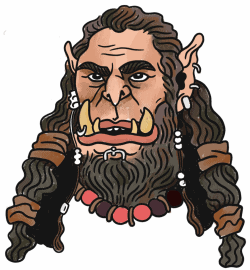Video games have historically been ill-suited towards film adaptations, but that hasn’t stopped studios from from trying to rework hastily written gaming plotlines into feature-length movies. With recent interest around adaptations of franchises like Metal Gear Solid and Pokémon, it’s worth looking back at a few of these cinematic cast-offs.
I hoped, by taking a scattershot approach, I’d find something good among the wreckage — I was wrong. I chose to watch the Super Mario Bros. movie, Doom and Warcraft. Despite the variety of subject matter, each of these films has a common denominator — no one on these productions had any idea what to do with their respective source material.
In the case of the Super Mario Bros. movie, the lack of direction is understandable. Molding the surreal imagery of the original games into a discernible plot is a tall order, and the Blade Runner and Ghostbusters dystopian hybrid that the filmmakers stumbled upon is bold if nothing else.
Rather than set up a plot, the movie opens with perhaps the laziest exposition for a movie I’ve ever witnessed. In a series of escalating what-ifs, the narrator asks the viewer to imagine a world where the dinosaurs never went extinct and evolved alongside humans in an alternate dimension. The title card drops, and the movie takes off from this bizarre premise.
The movie portrays the two brothers as crude Italian-American stereotypes played by Bob Hoskins and John Leguizamo, who make Tony Soprano and his friends look like upstanding examples positive representation. Rounding out the cast are post-Blue Velvet Dennis Hopper as King Koopa and a grotesque photo-realistic Yoshi.
This movie is a trainwreck, but it has its charms. Its attempts to ground the classic Nintendo mascot in reality are absurd, reimagining the title character as a surly Italian man who treats his job as a plumber as if he’s living by the Bushido code. It’s certainly dumb, but it’s hard to be mad about it as the source material is paper-thin to begin with.
Unlike the Mario movie, Doom does not contain any charm. This movie takes the over-the-top heavy metal cyberpunk aesthetic of the original game and waters it down into a reimagining of Alien starring a bunch of frat bros. The movie stars Dwayne Johnson, Karl Urban and Gone Girl star Rosamund Pike.
The Doom movie spends most of its runtime as a played-straight horror B movie about demons in outer space. In the last twenty minutes, the perspective shifts to first-person for some sleepy shooting-gallery antics that fail to capture the infamous speed of the original game before ending on a Dragon Ball Z style fight between two super soldiers. Just to tie everything together, a mid-period Nine Inch Nails song plays over the credits.
The spectre of Doom 3 — the 2004 flashlight management simulator that released a year prior to this film — looms large over the Doom film adaptation. The cheesy Iron Maiden album cover aesthetics and fast-paced gameplay of the original are neglected in favour of dull survival horror.
Unlike the first two movies I watched, Warcraft actually has a fully formed universe to draw from. Director Duncan Jones adapts the orcs-versus-humans nonsense of the original Warcraft game and plays it completely straight. The adaptation might be a little too faithful, as it name drops characters as if the audience should already know who they are.
Warcraft alternates between state-of-the-art Hollywood effects and Syfy original-level costuming. Large chunks of this movie are completely rendered in CGI, which made me wonder why this wasn’t just an animated feature in the first place.
Putting the cartoonish, candy-coloured world of Warcraft on the silver screen is ill-advised to begin with, but the movie tries its hardest to translate the aesthetic to film — impractically large shoulder pauldrons and all. The end result is kind of boring to look at but mostly just off-putting.
In the end, I think a lot of video-game adaptations fail because the storylines in games are usually just kind of bad. They occasionally work well within the context of a larger artistic work where the story is simply a way of grounding the gameplay, but often, they are unable to work independently.
I think, if future video-game adaptations are to succeed, filmmakers should be looking at original movies that are structured like games: Kill Bill, Scott Pilgrim vs. the World, Snowpiercer and Dredd are all films that have “levels” and “boss fights.” Without a structure similar to the source material, the plot of a game is left to do a lot of work that it was never meant to do.
Regardless of how these films have turned out, it looks as if these types of adaptations will continue into the foreseeable future. Hopefully, someone figures out a way to make a good gaming adaptation, especially if this continues as the latest Hollywood trend.
—
Cole Chretien / Culture Editor
Graphics: Jaymie Stachyruk / Graphics Editor